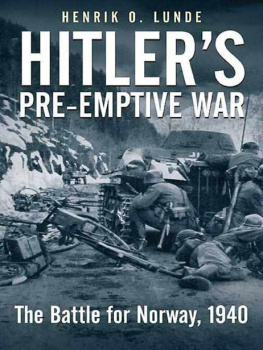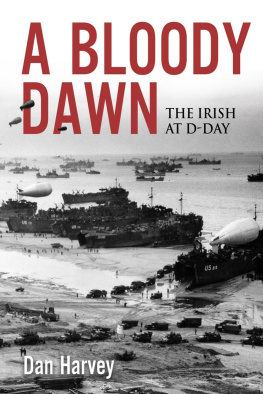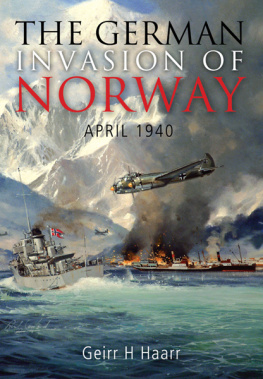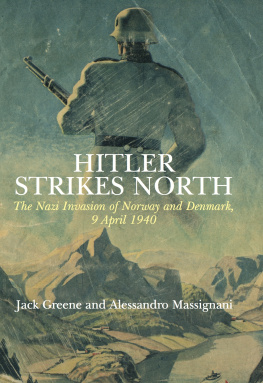Henrik O. Lunde
HITLERS PRE-EMPTIVE WAR
The Battle for Norway, 1940


PREFACE AND ACKNOWLEDGMENTS
There are many cogent reasons why the 1940 campaign in Norway has an enduring importance and why its study should be basic reading for students of military history, for military planners and operators, and for policymakers. The fact that it was the first campaign in history in which land, sea, and air forces were fully involved is sufficient to meet the above criteria. However, there are other compelling reasons.
For both the Germans and the Allies, the war in Scandinavia demonstrated the extreme risks and dangers inherent when undertaking a preemptive war or a war of choice. The Norway campaign remains a perfect example of how things can quickly unravel when the underlying assumptions governing plans are fallacious. Furthermore, the Allied and Norwegian responses to the manner and pace of the German attack provide classic examples of the results of the problems that have always faced military planners in democracies relying on poorly trained and equipped conscript forces.
Many writers have concluded that the German plans and preparations were kept so secret that the attack came as a complete surprise to the Norwegians and the Allies. In fact, there were numerous intelligence reports pointing to imminent German actions in Scandinavia. Policymakers and planners gave little credit to these reports because of their preconceived ideas about German capabilities and intentions; hence they failed to draw the conclusions that, perhaps, ought logically to have followed.
The rough geography and severe climate of Norway encouraged the Norwegians to believe that their country was easy to defend. This belief, combined with the scarcity of resources in the interwar period, left the country with inadequate military forces to meet a determined aggressor. The operations in north Norway show clearly that to commit forces in the Arctic without adequate equipment and training is a recipe for disaster.
The war was the first direct clash between German and Allied land and air forces. It was a testing ground for the innovations in equipment and doctrine developed since World War I. The effect of air power on both land and naval operations, little understood in Norway and Great Britain, was demonstrated clearly during the war in Norway, and caused a fundamental shift in how this new weapon was viewed. The campaign also saw the first use of airborne troops to seize airfields and key objectives far behind enemy lines.
The Norwegian campaign revealed serious deficiencies in Allied command structures and inter-allied coordination and cooperation. Failure to achieve unity of command plagued both sides, but with the Germans the command difficulties were largely overcome by a high degree of professionalism at the operational level.
Finally, the campaign in Norway provides a textbook example of two military operational philosophies: centralized versus flexible control.
The German invasion of Denmark and Norway is usually dealt with in a few pages in the better-known political or military histories of World War II. This is understandable. The campaigns of the war were spread across nearly six years around the world, and the one in Norway was a comparatively small affair, both in the size of forces involved and in the number of casualties.
Several accounts of the campaign were written shortly after the war by authors from all participating countries. The Campaign in Norway by T.K. Derry in 1952, which became the official British history of the campaign, is undoubtedly the most authoritative and most widely read account in English. However, this excellently written book suffers from some of the same problems that David Reynolds finds in Churchills multi-volume history of World War II. Both authors present British motives and actions in the most favorable light. For the most part, facts are presented correctly, but the reader is often misled or influenced by omissions, lack of balance, distortions, and the shifting of blame for failure. Although a number of books have been written by British authors since the 1950s, they are largely unknown on this side of the Atlantic. These works were primarily written for the British public, and deal mainly with Allied operations, in particular the naval aspects. Some accounts, by omission or through a narrow perspective, paint an inaccurate picture of events. While there are some well-written German and Norwegian accounts, they have not been translated and are therefore practically unknown outside their own countries.
There are a number of biographies of individuals involved in the Norwegian operations, both political and military, as well as a number of personal accounts and unit histories. These sources are valuable but must be treated with care. For example, it is often the case that writers of a biography fall in love with their subjects and therefore lose their objectivity, sometimes downplaying, overlooking, or excusing their subjects flaws and weaknesses.
A review of the studies available in English led this author to the conclusion that the treatment of the campaign, with few exceptions, is unbalanced. The operations of French, Polish, and Norwegian troops are invariably given far less coverage and credit than they deserve. Inconsistencies between national accounts are numerous and the impact of such factors as terrain, climate, training, and personalities are seldom addressed adequately.
The intent of this book is to treat planning and operations in a balanced manner, without a national focus, using sources from all participating countries. The planning and operations are analyzed in the light of what the participants knew or could have been expected to know. Hindsight analysis is avoided as far as possible. It is always easy to be wise after the event. While few things are more dangerous in the writing of a military history than hindsight, the mere recounting of events without analysis and objective critique makes it a useless exercise. The focus of this book was originally on military operations in and around Narvik and on the political decisions and planning leading up to those operations. However, while Narvik had a seemingly magnetic effect upon military planners before and during the warout of all proportion to its actual military importancethese operations cannot be understood in isolation. I soon realized that limiting my book to Narvik was unrealistic because that campaign was entwined with the whole of the war in Norway as well as in Europe generally.
I owe a special debt to those who have written about the various aspects of the war in Norway, and they are frequently referenced in text and notes. Among those who deserve special mention is retired Norwegian Major General Torkel Hovland, a former commander in north Norway. He provided a number of references at the outset that would otherwise have been difficult to locate.
The same is true for Hans Haugse, a retired Norwegian headmaster, who also put me in contact with Petter Sandvik, an individual with personal experiences from Narvik in 1940. Mr. Sandvik, in addition to his personal observations, provided materials from various institutions that proved useful. Lieutenant Colonel Palle Ydsteb of the Norwegian Defense Staff was kind enough to make available helpful information on the historical aspects of the defenses in north Norway. Magnor Kr. Fjellheim kindly provided photographs of the area around Narvik that illustrate the formidable terrain and climatic challenges to military operations. Colonel (US Army, Ret) Henry Gole reviewed the draft manuscript and provided valuable perspectives on the issues during our frequent discussions.













